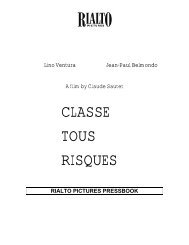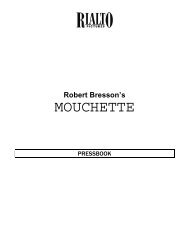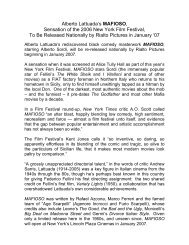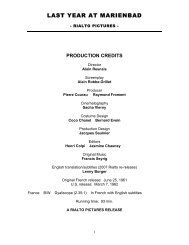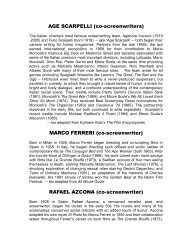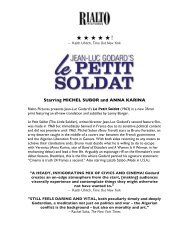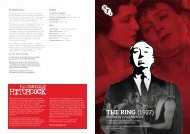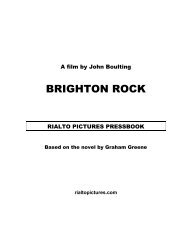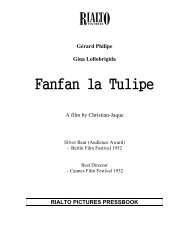download the Maculine Feminine Pressbook - Rialto Pictures
download the Maculine Feminine Pressbook - Rialto Pictures
download the Maculine Feminine Pressbook - Rialto Pictures
Create successful ePaper yourself
Turn your PDF publications into a flip-book with our unique Google optimized e-Paper software.
G O D A R D’ S<br />
MASCULINE FEMININE<br />
RIALTO PICTURES PRESS BOOK<br />
rialtopictures.com
Director<br />
Jean-Luc Godard<br />
Screenplay<br />
Jean-Luc Godard<br />
Based on “La Femme de Paul” and “Le Signe” by<br />
Guy de Maupassant 1<br />
Producer<br />
Anatole Dauman<br />
Cinematography<br />
Willy Kurant<br />
Editor<br />
Agnès Guillemot<br />
Songs<br />
Jean-Jacques Debout<br />
English subtitles (2004)<br />
Lenny Borger<br />
Pop song translations (2004)<br />
Bruce Goldstein<br />
A French-Swedish co-production<br />
Produced by Anouchka Films – Argos Films (Paris)<br />
Svensk Filmindustri – Sandrews (Stockholm) 2<br />
A RIALTO PICTURES RELEASE<br />
rialtopictures.com<br />
France, 1966 running time: 103 min.<br />
aspect ratio: 1.33:1 In French with English subtitles<br />
1 Upon seeing <strong>the</strong> film, <strong>the</strong> rightsholders of de Maupassant’s works decided <strong>the</strong> film bore<br />
no resemblance to <strong>the</strong> stories and gave <strong>the</strong> producer credit for a future project<br />
2 One year later, Sandrews would push <strong>the</strong> envelope of sexual frankness in <strong>the</strong> cinema even<br />
fur<strong>the</strong>r by producing Vilgot Sjoman’s controversial I Am Curious (Yellow).<br />
2
Paul<br />
Jean-Pierre Léaud<br />
Madeleine<br />
Chantal Goya<br />
Elizabeth<br />
Marlène Jobert<br />
Robert<br />
Michel Debord<br />
CAST<br />
Ca<strong>the</strong>rine-Isabelle<br />
Ca<strong>the</strong>rine-Isabelle Duport<br />
Herself<br />
Brigitte Bardot<br />
Himself (Man with Bardot)<br />
Antoine Bourseiller<br />
Woman with American Officer<br />
Françoise Hardy<br />
Man in <strong>the</strong> Movie<br />
Birger Malmsten<br />
Woman in <strong>the</strong> Movie<br />
Eva-Britt Strandberg<br />
“Miss 19”<br />
Elsa Leroy<br />
Record Producer<br />
Mickey Baker<br />
Man in <strong>the</strong> Métro<br />
Med Hondo<br />
Woman in <strong>the</strong> Métro<br />
Chantal Darget<br />
3
PAULINE KAEL ON “MASCULINE FEMININE”<br />
Masculine <strong>Feminine</strong> is that rare movie achievement: a work of grace and beauty in<br />
a contemporary setting. Using nei<strong>the</strong>r crime nor <strong>the</strong> romance of crime but a simple<br />
romance for a kind of interwoven story line, Godard has, at last, created <strong>the</strong> form<br />
he needed… essay, journalistic sketches, portraiture, love lyric and satire.<br />
The boy, a pop revolutionary (Jean-Pierre Léaud), is full of doubts and questions.<br />
The girl (Chantal Goya) is a yé yé 3 singer with a thin, reedy little voice; her face is<br />
haunting just because it's so empty — she seems alive only when she's looking in<br />
<strong>the</strong> mirror toying with her hair.<br />
Godard asks questions of youth and sketches a portrait in a series of questionanswer<br />
episodes that are <strong>the</strong> dramatic substance of <strong>the</strong> movie… There are<br />
informal boy-to-boy conversations about women and politics; <strong>the</strong>re is a<br />
phenomenal six-minute single-take parody-interview with a “Miss Nineteen,” who<br />
might be talking while posing for <strong>the</strong> cover of Glamour; and <strong>the</strong>re are two boy-girl<br />
sessions which define <strong>the</strong> contemporary meaning of masculine and feminine.<br />
… Godard captures <strong>the</strong> awkwardnesses that reveal <strong>the</strong> pauses, <strong>the</strong> pretensions,<br />
<strong>the</strong> mannerisms – <strong>the</strong> rhythms of <strong>the</strong> dance – as no one has before… He gets <strong>the</strong><br />
little things that people who have to follow scripts can’t get: <strong>the</strong> differences in <strong>the</strong><br />
way girls are with each o<strong>the</strong>r and with boys, and boys with each o<strong>the</strong>r and with<br />
girls. Not just what <strong>the</strong>y do, but how <strong>the</strong>y smile and look away.<br />
There’s life in Masculine <strong>Feminine</strong>, which shows <strong>the</strong> most dazzlingly inventive and<br />
audacious artist in movies today at a new peak.<br />
-- excerpted from The New Republic, November 19, 1966 4<br />
AWARDS<br />
JEAN-PIERRE LEAUD<br />
BEST ACTOR (SILVER BEAR), BERLIN FILM FESTIVAL<br />
YOUTH AWARD – BEST FILM FOR YOUNG PEOPLE<br />
– BERLIN FILM FESTIVAL 5<br />
3 slang for French pop music: see footnote 26.<br />
4 Kael’s review of Masculine <strong>Feminine</strong> for The New Republic convinced New Yorker editor<br />
William Shawn to hire her. “Godard was one of <strong>the</strong> reasons he hired me,” Kael once<br />
commented. “Shawn rarely sat through a movie, [but] he realized that <strong>the</strong>re was something<br />
to Godard. And I had been writing very lovingly about Godard.”<br />
5 Ironically, in France, <strong>the</strong> film was prohibited to persons under 18 -- “<strong>the</strong> very audience it<br />
was intended for,” griped Godard.<br />
4
SHORT SYNOPSIS<br />
Paul (Jean-Pierre Léaud), a romantic young idealist, completes his military service<br />
and meets aspiring pop singer Madeleine (Chantal Goya). Despite markedly<br />
different musical tastes (he’s into Bach) and political leanings (he’s a Communist;<br />
she’s clueless), <strong>the</strong> two soon become romantically involved and Paul moves in<br />
with Madeleine and her two roommates, Eliizabeth and Ca<strong>the</strong>rine (Marlène Jobert<br />
and Ca<strong>the</strong>rine-Isabelle Duport). Working as an opinion pollster, Paul meditates on<br />
his generation’s place in <strong>the</strong> shifting world of 1960’s Paris. Meanwhile, Madeleine<br />
pursues her musical career, striving for a Top 40 hit. But Paul’s quest for social<br />
and emotional fulfillment becomes more and more problematic as his relationship<br />
with Madeleine grows increasingly dysfunctional. Political debates ensue, and <strong>the</strong><br />
couple encounters a series of bizarre individuals who plunge Paul into fur<strong>the</strong>r<br />
confusion and isolation.<br />
SYNOPSIS IN 15 PRECISE CHAPTERS<br />
Notes and annotations by Bruce Goldstein and Hyoe Yamamoto<br />
1 Paul (Jean-Pierre Léaud) sits at a café, reciting a poem he is composing on<br />
<strong>the</strong> spot. Paul spots Madeleine (Chantal Goya) and starts talking to her. Paul<br />
explains that he’s just ended his mandatory sixteen months of army duty and<br />
needs a job. Madeleine promises to put in a good word for him at a magazine.<br />
Madeleine used to work at <strong>the</strong> magazine, but is now pursuing a career as a pop<br />
singer. A man and woman in <strong>the</strong> café have a heated argument. The woman takes<br />
a gun out of her purse and shoots <strong>the</strong> man in <strong>the</strong> back.<br />
2 In ano<strong>the</strong>r café, Paul meets Robert (Michel Debord), a factory worker on<br />
strike. He asks Paul to sign a petition to release political prisoners in Brazil 6 .<br />
Paul tells Robert that he needs a place to live. Robert asks him if he’s been seeing<br />
Madeleine, but Paul pretends that he’s not interested in her. “Not getting laid<br />
<strong>the</strong>n?” replies Robert.<br />
3 Madeleine is back working at <strong>the</strong> magazine, along with Ca<strong>the</strong>rine<br />
(Ca<strong>the</strong>rine-Isabelle Duport) and Paul. “The average French girl does not exist,”<br />
Ca<strong>the</strong>rine says in a voice-over. Paul follows Madeleine to <strong>the</strong> rest rooms to ask her<br />
to go out with him. She asks if “going out” means “sleep with me.” After some<br />
hedging, he blurts out that he wants to go to bed with her. The two grill each o<strong>the</strong>r<br />
on love and sex. Madeleine asks Paul what <strong>the</strong> center of <strong>the</strong> world is. Paul<br />
answers “love.” “I would have said ‘me’,” admits Madeleine.<br />
6 A political militant himself, Léaud in 1968 made a speech to hundreds of students at<br />
Brasilia University, in opposition to Brazil’s military dictatorship.<br />
5
4 Paul and Robert, carrying paint cans and a briefcase, are seen with<br />
Madeleine, Ca<strong>the</strong>rine, and Elizabeth (Marlène Jobert). Paul’s narration calls it “<strong>the</strong><br />
era of James Bond and Vietnam” and says how hope is sweeping <strong>the</strong> French left<br />
with <strong>the</strong> approaching December election 7 . He notes that Robert likes Ca<strong>the</strong>rine,<br />
who “is probably still a virgin but has <strong>the</strong> makings of a militant.” Paul and Robert<br />
spot an American officer with a pretty blonde woman (Françoise Hardy) 8 . While<br />
Paul chats with <strong>the</strong> officer’s chauffeur, Robert paints “PEACE IN VIETNAM” on <strong>the</strong><br />
side of <strong>the</strong> car. The two yell “U.S. out of Vietnam!” as <strong>the</strong> car drives away.<br />
Madeleine describes her developing relationship with Paul in a voice-over. RCA 9 is<br />
releasing her first single in a few days; she hopes it’s a hit so that she can buy a<br />
Morris Cooper. She explains that Elizabeth is jealous of her relationship with Paul<br />
and that she may let Paul sleep with her, as long as he doesn’t become a pest.<br />
On <strong>the</strong> Métro, Paul and Robert observe two black men and a white woman. One of<br />
<strong>the</strong> men indignantly explains that whites have no real understanding of <strong>the</strong> rage<br />
behind Charlie Parker, Bessie Smith and o<strong>the</strong>r black artists. The woman pulls a<br />
gun out and shoots him 10 .<br />
Ca<strong>the</strong>rine and Elizabeth discuss sex in <strong>the</strong>ir bathroom. Ca<strong>the</strong>rine talks about <strong>the</strong><br />
importance of physical pleasure, but Elizabeth stresses “<strong>the</strong> look” and emotions.<br />
5 Paul finally tells Madeleine that he wants to marry her, but <strong>the</strong> impatient<br />
Madeleine, preoccupied with <strong>the</strong> release of her single, asks to discuss it later.<br />
Chantal Goya’s “Laisse Moi” (“Leave Me Alone”) is heard on <strong>the</strong> soundtrack.<br />
6 Paul, Madeleine, and Elizabeth go out to a discothèque, where couples<br />
dance to “Laisse Moi.” At a snack bar, Elizabeth rhapsodizes over <strong>the</strong> singer<br />
Sandie Shaw 11 , but Paul says her music him sick. Insulted, Elizabeth and<br />
Madeleine leave him. A blonde girl asks him to take a picture with her in a photo<br />
7 See 1965: A HISTORICAL BACKGROUND, pages 20 and 21<br />
8 Hardy was France’s most popular pop singer since Brigitte Bardot. She became a<br />
sensation in 1962 with <strong>the</strong> hit single, Tous Les Garçons et Les Filles.<br />
9 RCA was Goya’s actual label. Her six pop songs from Masculine <strong>Feminine</strong>, all written<br />
by her future husband/manager Jean-Jacques Debout, were released in France as an<br />
extended play (EP) 45 rpm record. (This record was reissued on a Japanese CD in 2004.)<br />
10 This scene was freely adapted from Leroi Jones’ play Dutchman, which was filmed <strong>the</strong><br />
same year by director Anthony Harvey. The film starred Al Freeman Jr. and Shirley Clark.<br />
11 Sandie Shaw is a British pop singer whose career peaked in <strong>the</strong> mid-60s. She recently<br />
collaborated with Morrissey and The Smiths.<br />
6
ooth and offers to let him touch her breasts for 150 francs. Disgruntled, Paul<br />
walks into a recording booth and records an impromptu, stream-of-consciousness<br />
love message for Madeleine. Goya’s “Tu m’a trop menti” (“You’ve Lied Too Much<br />
to Me”) plays on <strong>the</strong> soundtrack as he walks into a games arcade. A man pulls a<br />
knife on him but instead stabs himself, falling into Paul’s arms.<br />
7 In a laundromat, Paul tells Robert that his landlord is kicking him out and<br />
that he hopes to move in with Madeleine. Robert reads aloud from a newspaper<br />
article about Bob Dylan, whom Paul hasn’t yet heard of. They joke about Dylan<br />
and “O! Yes!” bras 12 . Paul admits being sad about Madeleine. Robert asks if he<br />
ever noticed that <strong>the</strong> word “masculine” contained <strong>the</strong> words “mask” and “ass.” 13<br />
Paul asks what “feminine” contains. “Nothing,” says Robert.<br />
In a voice-over, Ca<strong>the</strong>rine tells of a new discovery – <strong>the</strong> transmitting of thoughts by<br />
injection -- and predicts that in 20 years everyone will be equipped with a device<br />
giving <strong>the</strong>m an instant orgasm. Robert, Elizabeth, and Madeleine each take a turn<br />
describing how consumerism will soon dominate human existence.<br />
8 In <strong>the</strong> girls’ flat, Ca<strong>the</strong>rine tells Paul that Madeleine’s worried about getting<br />
pregnant, but Paul insists he’s old enough to know not to go all <strong>the</strong> way. Ca<strong>the</strong>rine<br />
says that she herself uses a diaphragm. Madeleine comes home and announces<br />
that her record “Pinball Champ” is number six in Japan 14 . Paul ridicules Madeleine<br />
by spouting fan-magazine-type nonsense about her. She tells him to stop making<br />
fun of her, but Paul shows that he’s quoting directly from France Soir 15 .<br />
Paul eavesdrops, through a frosted window, on Madeleine and Elizabeth taking a<br />
shower toge<strong>the</strong>r. Ca<strong>the</strong>rine catches him with his hand in his pants. He pretends to<br />
be catching a flea.<br />
Paul, Madeleine and Elizabeth go to sleep toge<strong>the</strong>r. The three have a bedtime<br />
debate about <strong>the</strong> proper word for derrière. As Paul and Madeleine snuggle, he<br />
asks if he can touch her. She sleepily says yes, but tells him to “be gentle.” 16<br />
12 An actual brand. As a woman walks by, <strong>the</strong>y shout out its slogan: “O! Yes! What pretty<br />
breasts!”<br />
13 In French “masque” and “cul.” It works in both languages.<br />
14 Goya’s Si Tu Gagnes au Flipper (“If You Win at Pinball,” aka “Pinball Champ”)<br />
actually hit number 6 on <strong>the</strong> Japanese charts that year.<br />
15 In this scene, Ca<strong>the</strong>rine sings a song from Truffaut’s Jules and Jim, and Paul recites lines<br />
(“I have no old mo<strong>the</strong>r!”) from Renoir’s The Rules of <strong>the</strong> Game.<br />
16 “Sois gentil,” <strong>the</strong> title of one of <strong>the</strong> Goya hits on <strong>the</strong> soundtrack<br />
7
Paul walks into <strong>the</strong> kitchen, where Ca<strong>the</strong>rine is playing with a miniature guillotine.<br />
As <strong>the</strong> voice of André Malraux 17 is heard on <strong>the</strong> soundtrack, Ca<strong>the</strong>rine raises <strong>the</strong><br />
blade and lets it fall.<br />
9 Paul interviews “Miss 19” (Elsa Leroy). 18 She is completely ignorant of<br />
politics and embarrassed by his questions about birth control. This chapter is<br />
entitled DIALOGUE WITH A CONSUMER PRODUCT.<br />
10 Paul plays pinball in a café, as “Pinball Champ” plays on <strong>the</strong> jukebox.<br />
Sitting down for a meal with Elizabeth, Paul tells a story of how his fa<strong>the</strong>r<br />
discovered that <strong>the</strong> earth revolves around <strong>the</strong> sun while eating mashed potatoes.<br />
Paul says that Madeleine’s pregnant, but Elizabeth thinks she’s putting him on. At<br />
ano<strong>the</strong>r table, Brigitte Bardot 19 and actor/director Antoine Bourseiller go over lines<br />
from Jean Vauthier’s 1958 play “Les prodiges.”<br />
11 Paul and <strong>the</strong> three girls go to see an erotic Swedish film 20 (intermission<br />
music: Goya’s “Comment le revoir”). Just as things start getting hot on-screen,<br />
Paul jumps up, complaining that <strong>the</strong> film is being shown in <strong>the</strong> wrong aspect ratio.<br />
He dashes to <strong>the</strong> projection room and delivers a lecture to <strong>the</strong> projectionist. Bored,<br />
Paul and Elizabeth want to leave, but Ca<strong>the</strong>rine and Madeleine insist on staying.<br />
Paul says in a voice-over that <strong>the</strong> movie was disappointing and made him sad,<br />
because “it wasn’t that total film we carried inside ourselves.”<br />
12 Robert insists Ca<strong>the</strong>rine is in love with Paul. She denies it and says it’s<br />
none of his business. He gives her <strong>the</strong> third degree about her sex life. She in turn<br />
grills him on his own predilections. Goya’s “Sois gentil” (“Be gentle”) is heard in <strong>the</strong><br />
background. An intertitle coins Godard’s most famous quotation:<br />
THIS FILM COULD BE CALLED<br />
THE CHILDREN OF MARX AND COCA-COLA<br />
17 One of <strong>the</strong> most famous French novelists of <strong>the</strong> 20 th century (Man’s Fate, etc.) and a<br />
hero of <strong>the</strong> French forces during WWII, André Malraux (1901-1976) was appointed<br />
Minister of Information by DeGaulle following <strong>the</strong> war. He was made Minister of Cultural<br />
Affairs in 1960 and in 1968 would achieve infamy in film circles for deposing Henri<br />
Langlois as head of <strong>the</strong> Cinémathèque Française, a move reviled by Godard, Truffaut, et al.<br />
18 Leroy was <strong>the</strong> real-life “Mademoiselle Age Tendre” (Miss Tender Age) for 1965<br />
19 Three years before, Bardot had starred in Godard’s Contempt.<br />
20 The film-within-<strong>the</strong>-film is a remake of Godard’s own 1955 short Une femme coquette,<br />
(based on de Maupassant’s Le Signe), which starred Godard as <strong>the</strong> man. In Masculine<br />
<strong>Feminine</strong>, <strong>the</strong> man is played by Birger Malmstem, star of Ingmar Bergman’s earliest films.<br />
8
13 A man asks Paul for a match and walks away. Paul follows him off-screen.<br />
He comes back to report that <strong>the</strong> man has set himself on fire in front of <strong>the</strong><br />
American hospital. A disbelieving Madeleine walks off-screen and comes back to<br />
confirm that <strong>the</strong> man really did set himself on fire 21 .<br />
14 Ca<strong>the</strong>rine and Paul visit Madeleine at a studio 22 , where she’s recording her<br />
second single, “D’abord, dis-mois ton nom” (“First tell me your name”). Madeleine<br />
is interviewed for a radio program outside <strong>the</strong> studio. She’s asked if she belongs to<br />
<strong>the</strong> Pepsi Generation 23 , among o<strong>the</strong>r completely trivial questions. Paul claims to<br />
have stolen a car, but Madeleine points out that he’s “no Pierrot Le Fou.” 24<br />
Against shots of everyday working class Paris life, Paul’s narration tells about his<br />
work as an opinion pollster, in which he asks <strong>the</strong> average person in <strong>the</strong> street<br />
questions ranging from “Why are society women more frigid than factory girls” to<br />
“Did you know <strong>the</strong>re’s an Iraqi-Kurd war on?”<br />
15 At a police station, Ca<strong>the</strong>rine explains <strong>the</strong> circumstances by which Paul fell<br />
out of a window in his new high-rise apartment. She says it wasn’t a suicide, but a<br />
stupid accident. Madeleine is asked what she’s going to do with her unborn child.<br />
She says she’s not sure. Elizabeth had suggested using a curtain rod to abort <strong>the</strong><br />
baby, but Madeleine is still not sure.<br />
The word FEMININ appears on screen…five middle letters disappear to spell<br />
FIN<br />
21 In November 1965, Quaker Norman Morrison immolated himself in front of The<br />
Pentagon in protest of <strong>the</strong> war in Vietnam. A week later, 22-year-old Roger Allen LaPorte<br />
set himself on fire in front of <strong>the</strong> UN building in New York. Earlier in <strong>the</strong> year, two o<strong>the</strong>r<br />
Quakers had protested in <strong>the</strong> same fashion.<br />
22 Goya’s producer in this scene is Mickey Baker, a legendary R&B guitarist who, with<br />
Chuck Berry and Bo Diddley, is considered a major figure in <strong>the</strong> move from R&B to rock.<br />
23 In 1963, Pepsi-Cola began a media blitz with a campaign targeted directly at <strong>the</strong><br />
consumer-oriented post-war baby boomers. “Come Alive! You’re in <strong>the</strong> Pepsi<br />
Generation!” made advertising history. As one advertising website points out, it was “<strong>the</strong><br />
first time a product is identified, not so much by its attributes, as by its consumers’<br />
lifestyles and attitudes.”<br />
24<br />
Godard’s Pierrot Le Fou, was released in November 1965, <strong>the</strong> month shooting began on<br />
Masculine <strong>Feminine</strong>, so Godard is in effect plugging his latest film. In <strong>the</strong> same scene,<br />
Paul makes up <strong>the</strong> name “General Doinel,” a reference to Antoine Doinel, <strong>the</strong> character<br />
Léaud made famous in Truffaut’s films.<br />
9
ON THE SET OF “MASCULINE FEMININE”<br />
excerpted from “One Evening, in a Small Café” by Phillippe Labro<br />
When I arrive at <strong>the</strong> little café on Boulevard Edgar Quinet, <strong>the</strong> film crew is already<br />
<strong>the</strong>re. There aren’t a whole lot of <strong>the</strong>m: sitting in a corner, very inconspicuously, is<br />
Jean-Pierre Léaud, looking thinner and more lost in thought than <strong>the</strong> last time I<br />
saw him. Someone introduces me to Godard (faded raincoat, a tired look about<br />
him, going bald, smoking a king-size cigarette with yellow paper, a voice that is<br />
soft and tense at <strong>the</strong> same time, strong bony hands). He is very pleasant, very<br />
polite.<br />
“Sure it doesn’t bo<strong>the</strong>r you if I watch you work?”<br />
“Not at all.” (Before that, he said “How do you do.”)<br />
“If you have dirty shirts you need washed, here’s your chance; we’re filming in <strong>the</strong><br />
laundromat next door.”<br />
He films many scenes in cafés like this one. They are never very attractive, never<br />
“picturesque,” <strong>the</strong>y’re ordinary bistros with neon, a jukebox in a corner, benches, a<br />
bar; this is his vision of our world. He films in black and white, for a normal sized<br />
screen. The film will cost no more than sixty million old francs, a paltry sum.<br />
He’s <strong>the</strong> only one who really knows what’s going on at all times; <strong>the</strong> only thing <strong>the</strong><br />
rest of <strong>the</strong> crew has as a guide, as a sort of work plan, is a thin notebook of a<br />
dozen pages or so, divided into what <strong>the</strong>y call “work sequences” (<strong>the</strong>re are thirteen<br />
of <strong>the</strong>m), but when <strong>the</strong> real shooting starts, Jean-Luc Godard gets out his<br />
sketchbook (an 8”x12” spiral notebook with a blue cover). The dialogue and <strong>the</strong><br />
scene directions are recorded in it in his handwriting (dark blue ink, lines close<br />
toge<strong>the</strong>r, without too many things crossed out). He has his actors and actresses<br />
read <strong>the</strong>se over once or twice; “he has <strong>the</strong> whole film in his head,” <strong>the</strong>y say.<br />
The minute he begins working, it is crystal clear, blindingly clear, strikingly clear<br />
that nothing else counts, that his supposed “nervousness on <strong>the</strong> set” is really only<br />
extraordinary concentration, that this man knows exactly, to <strong>the</strong> foot almost, to <strong>the</strong><br />
second almost, to <strong>the</strong> interjection almost, what he wants, and that as long as he<br />
doesn’t get it, he will not for a second relax this passionately intense, electric<br />
atmosphere that he creates around his little world, nor will his mottled face lose for<br />
a single second its icy, desperate expression (for that matter, does he ever lose it?<br />
Godard wears a mask that resembles his films: it is desperate), nor will his voice<br />
lose its monotonous, thin, metallic, not really cold, but a little nasty, tone, a tone<br />
that in <strong>the</strong> end is fascinating, for at <strong>the</strong> same time it is a tone of intelligent<br />
authoritativeness.<br />
Godard speaks to his actor:<br />
10
“Let’s start over; pay a little attention now. What is it you can say? If you can’t say<br />
it, don’t say it. You are absolutely not thinking, not for a second, about what you’re<br />
saying. You lighted your cigarette; I didn’t tell you to do that in this shot. You can’t<br />
do just any old thing, just because we film <strong>the</strong> way amateurs do!”<br />
These last words (<strong>the</strong> key words) are pronounced with one of <strong>the</strong> rare smiles (half<br />
sardonic, half affectionate) of <strong>the</strong> long evening. Then, seeing that Léaud is still<br />
chagrined because he didn’t do <strong>the</strong> right thing, he says, kindly and calmly:<br />
“Don’t think of anything, don’t think of anything, do as I do. Keep your head empty.<br />
It’s <strong>the</strong> secret of being relaxed.”<br />
And with this, suddenly and at long last, Godard’s text, pronounced with that<br />
terribly false tone that people have when <strong>the</strong>y’re speaking (and which is bound to<br />
make <strong>the</strong> scene ring true when you see it in your <strong>the</strong>ater seat), comes out:<br />
“You’ve got to throw yourself into <strong>the</strong> struggle, and by being in it, you end up<br />
learning. You put up with too much. That’s impossible…”<br />
At two o’clock in <strong>the</strong> morning, Godard grinds out his tenth or twelfth yellow<br />
cigarette butt underfoot, puts his raincoat on, and says to <strong>the</strong> whole film crew:<br />
“Come on, we’re through.”<br />
He shakes one or two hands, but that is all, and starts off, his notebook under his<br />
arm. We make our way, through a Montparnasse that is sound asleep, to <strong>the</strong><br />
“Rosebud,” where we are going to drink beer and have some hot beans. As we’re<br />
sitting around <strong>the</strong> table, I ask Godard a few questions:<br />
“Is your film a sequel to Pierrot Le Fou? That was a film full of despair.”<br />
“Yes, this one won’t be very gay ei<strong>the</strong>r.”<br />
“Pierrot was a big commercial success.”<br />
“Yes, but it was a show, <strong>the</strong>re was something of a show about it; this one won’t be<br />
like that at all, it’ll be an anti-show. With Pierrot, people felt things; <strong>the</strong>y didn’t<br />
understand, but <strong>the</strong>y felt something. They said: ‘Well, he’s putting on a show.’ It<br />
was an emotional subject, <strong>the</strong>re was nothing reflective about it. There won’t be in<br />
Masculine <strong>Feminine</strong> ei<strong>the</strong>r, but it will be a film between one reflection and ano<strong>the</strong>r.<br />
There are times when you don’t necessarily need a baby, but it so happens you<br />
have one anyway. It’s <strong>the</strong>re, it exists, it would perhaps be better if it had come<br />
along at some o<strong>the</strong>r time. But when it’s <strong>the</strong>re, you dress it in whatever’s at hand.<br />
That’s what this film is. Moreover, I think I’m going to change <strong>the</strong> title; I’m going to<br />
call it Masculine <strong>Feminine</strong> Junior.”<br />
11
“Could it be said, <strong>the</strong>n, that it’s a film ‘about young people’?”<br />
“Yes and no. It’s about things that young people say. It’s about people, not about a<br />
world. I think that young people have a completely different world that we don’t<br />
know about. If you ask Chantal Goya what <strong>the</strong> Popular Front 25 is, it has no<br />
meaning for her; she doubtless knows what it is, but it doesn’t mean anything. A<br />
five-year-old child knows what a satellite is, <strong>the</strong>re’s nothing magic about it any<br />
more, and <strong>the</strong>re is <strong>the</strong>refore a completely different way of thinking. I would like<br />
people to find this feeling in it; it’s a film on <strong>the</strong> idea of youth. But when you say<br />
youth, it’s not necessarily a matter of kicking up your heels. I’m thirty-five and I still<br />
consider myself somebody who’s young, so <strong>the</strong> ones who are eighteen have a<br />
totally different world. Chantal Goya, for instance: I was looking for somebody and<br />
I was very happy to come across her. She’s great. She’s <strong>the</strong> “Pepsi Generation.”<br />
“Is she a good singer?”<br />
“She’s number six in Japan. But she jokes about it. It’s a funny world – <strong>the</strong>se very<br />
young people who earn money and have maids and secretaries <strong>the</strong>ir own age.<br />
Records are marvelous – <strong>the</strong>y’re better than writing a book or making a film. It’s<br />
easier, <strong>the</strong>y often don’t even know how to sing, it’s a quick way to earn money.”<br />
“Is this mixing of Vietnam and <strong>the</strong> yé yé 26 generation a deliberate thing?”<br />
“Of course – or at least it’s true that Bob Dylan is a link between <strong>the</strong> yé yé kids and<br />
politics, a way to bring <strong>the</strong> two toge<strong>the</strong>r. But, you know, I think it was Baudelaire<br />
who said that it was on <strong>the</strong> toilet walls that you see <strong>the</strong> human soul: you see graffiti<br />
<strong>the</strong>re – politics and sex. Well, that’s what my film is.”<br />
“Is it as autobiographical as Pierrot? Or, for that matter, was Pierrot<br />
autobiographical?”<br />
“Pierrot le fou wasn’t really autobiographical. I think it was Truffaut who said – and<br />
<strong>the</strong> same thing goes for my films – that in his films <strong>the</strong>re was 20 per cent<br />
autobiography, 20 per cent things you’ve read, 20 per cent things you’ve heard, or<br />
been told, 20 per cent fiction, and 20 per cent something else I don’t remember.”<br />
“And what are you shooting tomorrow?”<br />
25 The Popular Front was a coalition of left-wing political parties in Spain, created in <strong>the</strong><br />
1930s to gain political strength against Franco’s Fascists.<br />
26 “Yé yé” (derived from English pop’s “yeah, yeah, yeah”) is slang for French pop music.<br />
The king of yé yé was (and perhaps still is) Johnny Hallyday, <strong>the</strong> country’s answer to Elvis<br />
Presley. The years 1962 to 1966 saw an explosion of yé yé girl singers including Françoise<br />
Hardy, Sheila, France Gall, Chantal Goya, and any number of one-hit wonders.<br />
12
“We’re filming a scene in <strong>the</strong> Métro, where it goes above ground. Léaud goes up<br />
<strong>the</strong>re with his friend because between two stations <strong>the</strong> train passes by <strong>the</strong> window<br />
of girls he knows; so <strong>the</strong>y’re going to try to see <strong>the</strong> girls getting undressed; but <strong>the</strong><br />
train goes by so fast that <strong>the</strong>y miss out. Then <strong>the</strong>y witness a sort of argument<br />
between a Negro and a girl. It isn’t written yet. I’ll write it tomorrow.”<br />
GODARD ON “MASCULINE FEMININE”<br />
Excerpted from an interview with Pierre Daix<br />
Originally published in Les Lettres Françaises (June 1966)<br />
Would you say Masculine <strong>Feminine</strong> is film about youth?<br />
GODARD: No, it’s more a film on <strong>the</strong> idea of youth. A philosophical idea, but not a<br />
practical one – a way of reacting to things. It’s not a dissertation on youth or even<br />
an analysis. Let’s say that it speaks of youth, but it’s a piece of music, a “concerto<br />
of youth.” I have taken young signs, signs that have not yet been deformed. My<br />
signs haven’t already been used a thousand times. I can talk about <strong>the</strong>m now,<br />
afterward, because when I made this film, I didn’t have <strong>the</strong> least idea of what I<br />
wanted.<br />
One gets <strong>the</strong> feeling that you started with a band of young people, and that<br />
as you went along you conducted <strong>the</strong> surveys, letting yourself be more or<br />
less guided by <strong>the</strong>m.<br />
That’s true. The film was a way for me to approach <strong>the</strong>m.<br />
To approach <strong>the</strong>m as someone who is older than <strong>the</strong>y are?<br />
I think that I’m as young as <strong>the</strong>y are. I noticed that I was both older and younger<br />
than <strong>the</strong>y were.<br />
What’s most striking to me was that this is a film not about youth, <strong>the</strong> way<br />
that films on <strong>the</strong> same subject by Carné or De Sica are; it’s a film with<br />
youth.<br />
True. At <strong>the</strong> same time I chose young people because I no longer have any idea<br />
where I am from <strong>the</strong> point of view of cinema. I am in search of cinema. It seems to<br />
me that I have lost it. Talking with young people was an easier way to find myself<br />
than talking with adults. I have <strong>the</strong> impression that, if a person is young, he must<br />
give of himself, and he does so willingly, without ulterior motives, and if he gives<br />
himself away, he’s not unhappy. For me <strong>the</strong>se were people who had not been<br />
conditioned. Conditioned by <strong>the</strong>ir life, certainly, but not morally conditioned. Even<br />
when <strong>the</strong>y react badly, or when <strong>the</strong>y don’t want to come right out and say<br />
something, <strong>the</strong>re’s a certain spontaneity, a certain innocence. I wanted to use<br />
cinema to speak of youth, or else I wanted to use youth to speak of cinema.<br />
13
Have you had any reactions to your film from young people, outside of<br />
those who have worked in it?<br />
No. Since <strong>the</strong> film is prohibited to people under eighteen, I have no idea whe<strong>the</strong>r it<br />
interests <strong>the</strong>m. I think <strong>the</strong>re should be a good twenty films like it, from different<br />
backgrounds – in <strong>the</strong> provinces, in <strong>the</strong> North, in <strong>the</strong> South. Films that television<br />
ought to do but doesn’t, because television only fills up a schedule. Which are<br />
often hours well spent, but are not genuine works. They don’t think like painters or<br />
novelists; <strong>the</strong>y forget works of imagination. And works of imagination are<br />
none<strong>the</strong>less what lie closest to people’s hearts.<br />
I believe that if young people could see it – young people <strong>the</strong> same age as<br />
Léaud – <strong>the</strong> film would go on in <strong>the</strong>ir heads after <strong>the</strong> movie had ended.<br />
The three or four young people who played in it could have experienced what went<br />
on in <strong>the</strong> film ra<strong>the</strong>r than something else. There is no difference between what <strong>the</strong>y<br />
did during <strong>the</strong> day and what <strong>the</strong>y represented in <strong>the</strong> film; it was exactly <strong>the</strong> same.<br />
You disturb <strong>the</strong> traditional relationship between <strong>the</strong> director and his actors.<br />
I’m sure of one thing, that this is what cinema means to me, and that this is what it<br />
has never been; it went off track immediately. When Lumière first invented cinema,<br />
<strong>the</strong> last thing he had in mind was a spectacle. One day a guy said to him, “Come<br />
show your gimmick in my neighborhood and we’ll make people pay.” But Lumière<br />
was an artist, not a showman. I know very well that cinema is a sort of industry,<br />
one that’s got to make a profit and that’s part show business. But in my work<br />
<strong>the</strong>re’s always a part that’s not a show at all and yet it comes through quite nicely,<br />
like an informal lecture, or a course at <strong>the</strong> Sorbonne, or a concert. The <strong>the</strong>ater is<br />
pure show; it’s magnificent. Cinema – a film by Jacques Demy or [Max Ophuls’]<br />
Lola Montes – can be pure spectacle. O<strong>the</strong>r films are both, and still o<strong>the</strong>rs that<br />
have absolutely nothing to do with this. They can be bad – that’s ano<strong>the</strong>r question<br />
entirely – but <strong>the</strong>y’re searching for something.<br />
Do you think cinema as an art is in good health?<br />
From <strong>the</strong> point of view of images and sound alone, I think cinema is in better<br />
health than ever. People need it, above all in France where <strong>the</strong> population is<br />
getting younger. It’s young people who go to <strong>the</strong> movies, and <strong>the</strong>y haven’t found<br />
<strong>the</strong>ir films, <strong>the</strong>ir television shows. They’ve found <strong>the</strong>ir music, but <strong>the</strong>y haven’t really<br />
found <strong>the</strong> image that goes with it.<br />
14
JEAN-LUC GODARD (Director/Writer)<br />
Born December 3, 1930 in Paris, <strong>the</strong> son of a doctor and a banker's daughter,<br />
Godard had his elementary and high school education in Switzerland and in Paris,<br />
<strong>the</strong>n enrolled at <strong>the</strong> Sorbonne, ostensibly to study ethnology. During his university<br />
days he developed a passionate devotion to <strong>the</strong> cinema, spending endless hours<br />
at Left Bank cinema clubs and at <strong>the</strong> Cinémathèque Française, where in 1950 he<br />
met <strong>the</strong> critic André Bazin and future filmmakers François Truffaut, Jacques<br />
Rivette, Eric Rohmer, and Claude Chabrol, with whom he would later form <strong>the</strong><br />
nucleus of <strong>the</strong> French New Wave. Godard began contributing articles and film<br />
criticism for La Gazette du Cinéma, <strong>the</strong>n Cahiers du Cinéma.<br />
In 1951, Godard toured North and South America. Supporting himself with a<br />
variety of odd jobs, he continued watching films at a fanatical rate, and his articles<br />
for Cahiers began reflecting an enthusiastic admiration for little-known American<br />
directors of action films and at <strong>the</strong> same time a deep contempt for <strong>the</strong> traditional<br />
cinema, especially <strong>the</strong> commercial French film.<br />
In 1954, Godard returned to Switzerland and remained <strong>the</strong>re to work as a laborer<br />
on a dam project. With his earnings he bought himself a 35mm camera and made<br />
his first film, Opération Beton, a 20-minute short about <strong>the</strong> construction of <strong>the</strong> dam.<br />
Following four more shorts, Godard stunned <strong>the</strong> world with his first feature film,<br />
Breathless, released early in 1960. The film marked a significant break from<br />
orthodox cinema techniques, reshaping <strong>the</strong> traditional film syntax with its<br />
astonishing jump cuts and unsteady hand-held moving shots. It was a<br />
spontaneous, impulsive, vibrant, and totally original film that reflected <strong>the</strong> director's<br />
enchantment with <strong>the</strong> immediacy of <strong>the</strong> American gangster movie and his<br />
impatience with <strong>the</strong> laboriousness of <strong>the</strong> traditional techniques of "quality" cinema.<br />
It immediately established Godard as a leading spokesman of <strong>the</strong> Nouvelle Vague.<br />
Godard's next film, Le Petit Soldat, was a savage exposition of <strong>the</strong> Algerian conflict<br />
and also <strong>the</strong> first of seven features to star his future wife Anna Karina. Karina next<br />
played a stripper in his A Woman Is a Woman (1961, re-released by <strong>Rialto</strong><br />
<strong>Pictures</strong> in 2003) and a Paris prostitute in My Life to Live (1962). Les Carabiniers<br />
(1963) was an anti-war allegory that provoked violently hostile reaction from<br />
audiences. Its grainy dreariness stood in sharp contrast to <strong>the</strong> wide-screen color<br />
cinematography of Contempt (1963, re-released by <strong>Rialto</strong> & Strand Releasing in<br />
1997), which starred Brigitte Bardot and Michel Piccoli.<br />
With Band of Outsiders (1964, re-released by <strong>Rialto</strong> <strong>Pictures</strong> in 2001), Godard<br />
returned to <strong>the</strong> world of <strong>the</strong> gangster. A Married Woman (1964) was <strong>the</strong> study of<br />
an alienated Parisian woman. Alphaville (1965), Godard's only excursion into<br />
science fiction, was followed in <strong>the</strong> same year by Pierrot le Fou.<br />
15
Godard’s impact on <strong>the</strong> cinema of <strong>the</strong> 60s was monumental and sweeping. He<br />
used <strong>the</strong> camera inventively, re-writing <strong>the</strong> syntax of films along <strong>the</strong> way.<br />
Masculine <strong>Feminine</strong> (1966) was a free-form study of <strong>the</strong> mores of Parisian youth.<br />
Made in USA (1966) was based on an American potboiler. Two or Three Things I<br />
Know About Her (1967) told <strong>the</strong> story of a Paris housewife who moonlights as a<br />
prostitute. La Chinoise (1967) featured in <strong>the</strong> leading role actress Anne<br />
Wiazemsky, who became Godard's second wife.<br />
After Week End (1968), a new Godard surfaced, a revolutionary, didactic<br />
filmmaker who became obsessed with <strong>the</strong> spoken word and increasingly apa<strong>the</strong>tic<br />
to cinema as a visual medium. He dedicated himself to making "revolutionary films<br />
for revolutionary audiences."<br />
In <strong>the</strong> late 70s Godard underwent yet ano<strong>the</strong>r metamorphosis, rediscovering<br />
himself and his love of film. He refocused his sights on <strong>the</strong>mes of universal<br />
humanistic concern in Every Man for Himself (1980), Passion (1982), and First<br />
Name: Carmen (1983). He even paid a renewed homage to American cinema in<br />
Détective (1985), but caused massive controversy with his Hail Mary! (1985).<br />
King Lear (1987) was an unsuccessful attempt to film Shakespeare. Soigne ta<br />
droite (1987), Nouvelle Vague (1990) and Hélas pour moi (1994) all featured top<br />
stars, but his For Ever Mozart (1997), with its typically Godardian disquisition on<br />
art and war, was <strong>the</strong> best received of <strong>the</strong> four.<br />
In 1998, Godard completed his long-gestating Histoire(s) du Cinéma, a highly<br />
personal meditation on 100 years of cinema, which was released on video and in<br />
book form. O<strong>the</strong>r works of <strong>the</strong> 90s include Germany Year 90 Nine Zero, <strong>the</strong> selfportrait<br />
JLG/JLG (1995).<br />
In 2003, he made In Praise of Love, a surprisingly moving study of art, history,<br />
madness and exploitation and, last year, Notre Musique, shot on location in<br />
Sarajevo. Morceaux choisis (literally, “choice bits”), a 90-minute re-edit of his<br />
Histoire(s) du Cinéma, was shown this winter at <strong>the</strong> Pompidou Center in Paris and<br />
was <strong>the</strong> opening night film of <strong>the</strong> re-opened Museum of Modern Art in New York.<br />
Among his many prizes and honors, Godard won <strong>the</strong> best director award at <strong>the</strong><br />
Berlin Festival for Breathless, a Berlin Jury Prize for A Woman Is a Woman, and<br />
Venice’s Golden Lion (Best Film) for First Name: Carmen. In 1986, he was<br />
honored with a Special French César Award for lifetime achievement.<br />
Adapted from Ephraim Katz’s Film Encyclopedia; updated by Lenny Borger<br />
16
JEAN-PIERRE LEAUD (Paul)<br />
Born in Paris in 1944, Léaud’s on-screen life was given birth in The 400 Blows<br />
(1959), as director François Truffaut’s fictional alter ego Antoine Doinel. This film,<br />
which lingered in affectionate close-up on <strong>the</strong> face of <strong>the</strong> young actor, introduced a<br />
performative energy that was defiant, withdrawn, and, at <strong>the</strong> same time, fragile and<br />
exposed. It is for this role and <strong>the</strong> subsequent films in <strong>the</strong> Doinel cycle [Antoine et<br />
Colette (1962), Stolen Kisses (1968), Bed and Board (1970), Love on <strong>the</strong> Run<br />
(1979)] that Léaud remains best known 27 . Doinel, <strong>the</strong> hapless romantic frustrated<br />
by modern life, has become one of <strong>the</strong> best-loved characters in French cinema.<br />
During <strong>the</strong> same period, Léaud made a number of films with Jean-Luc Godard. 28<br />
These roles were poles apart from Doinel but also exploit <strong>the</strong> outsider quality that<br />
is intrinsic to Léaud. However, where Léaud’s performances for Truffaut were that<br />
of a lonely, romantic outsider, for Godard, Léaud was a dogmatic and often<br />
didactic idealist who also skirted <strong>the</strong> fringes of life. Truffaut described Léaud’s<br />
Doinel persona as one who "does not openly oppose society (and in this sense is<br />
not a revolutionary), but he is wary of it and goes his own way, on <strong>the</strong> outskirts of<br />
society." 29 Godard, on <strong>the</strong> o<strong>the</strong>r hand, almost always had Léaud play a<br />
revolutionary or ideologue, and in many ways, this was closer to <strong>the</strong> truth of <strong>the</strong><br />
performer. Truffaut biographers Antoine De Baecque and Serge Toubiana wrote:<br />
Both directors used Jean-Pierre Léaud as an actor, but in<br />
opposite ways. Truffaut was often appalled or wounded<br />
by Léaud’s personal choices and his commitment to leftwing<br />
militancy. The actor for his part surely felt closer to<br />
Godard, even though, on a human level, he remained<br />
extremely attached to Doinel’s creator. 30<br />
Regardless of <strong>the</strong> personal dynamics, both directors attached enormous<br />
importance to Léaud as a principal performer in <strong>the</strong> early stages of <strong>the</strong>ir careers.<br />
Léaud expressed a defining characteristic of both directors: like Doinel, like many<br />
28 Masculine <strong>Feminine</strong> was Léaud’s first major role for <strong>the</strong> director. He also played leading<br />
roles in Godard’s Made in U.S.A., La Chinoise, Week End, Grandeur et decadence (made<br />
for French television), Le Gai Savoir, and Détective,, along with cameos in Pierrot Le Fou<br />
and Alphaville.<br />
29 quoted from Truffaut’s introduction to <strong>the</strong> collected Doinel screenplays (The Adventures<br />
of Antoine Doinel, Simon and Schuster, 1971)<br />
30 Truffaut, Alfred A. Knopf, 1999<br />
17
of <strong>the</strong> Godard characters and like both directors, Léaud, Truffaut’s biographers<br />
explain, "doesn’t reject society; it is society that takes issue with his spirit and style<br />
of life." These men are all bound up in an energetic verve that is dulled by <strong>the</strong><br />
constraints of society. Childlike: Truffaut in emotions and romance, Godard in<br />
anger and ideals, and Léaud in body and spirit.<br />
Léaud won <strong>the</strong> Best Actor Award (Silver Bear) for his disarming performance in<br />
Masculine <strong>Feminine</strong>.<br />
Excerpted from Because of Tenderness: Thoughts on <strong>the</strong> Performance of<br />
Jean-Pierre Léaud by Rhys Graham (collected in Senses of Cinema)<br />
CHANTAL GOYA (Madeleine)<br />
Born Chantal Deguerre in Saigon in 1946, Goya moved to Paris when she was<br />
four. At <strong>the</strong> behest of Jean-Jacques Debout, Goya auditioned at RCA Records for<br />
legendary R&B guitarist Mickey Baker. The audition was a success, and, in 1964,<br />
Goya’s first single, C'est bien Bernard, propelled her into yé yé stardom 31 .<br />
In 1966, while filming Masculine <strong>Feminine</strong>, she became pregnant with Debout’s<br />
child, and <strong>the</strong> two married. The couple enjoyed an artistic partnership: Debout<br />
penned <strong>the</strong> majority of his wife’s songs until Goya's yé yé period ended in 1967.<br />
In <strong>the</strong> 1970s, Goya again became popular, this time for her work performing<br />
children's songs. The singer made a comeback in 1998 with <strong>the</strong> release of Les<br />
Années 60, an anthology of her 60’s hits. In 2001, Goya re-appeared in <strong>the</strong><br />
French Top 40 when her song Becassine Is My Cousine hit number 26 in <strong>the</strong><br />
charts. The song was also released in rap and techno-remix versions.<br />
The six Goya songs heard on <strong>the</strong> Masculine <strong>Feminine</strong> soundtrack (all written by<br />
husband Jean-Jacques Dubout) are “D’abord dis-moi ton nom,” “Laisse-moi,” “Si tu<br />
gagnes au flipper” (aka “Pinball Champ”), “Tu m’a trop menti,” “Comment le revoir”<br />
and “Sois gentil” (words by Roger Dumas). An album of <strong>the</strong> soundtrack songs was<br />
released in France and reissued on CD in Japan in 2004.<br />
WILLY KURANT (Cinematographer)<br />
A leading cinematographer of <strong>the</strong> French New Wave, Kurant began his feature film<br />
career as DP on Agnes Varda’s Les Créatures. He has shot films for Orson<br />
Welles, (The Immortal Story) Jerzy Skolimowski (Le Départ), Maurice Pialat (Sous<br />
le Soleil de Satan), among many o<strong>the</strong>rs. Following Masculine <strong>Feminine</strong>, he shot<br />
<strong>the</strong> Godard sequence of Far From Vietnam.<br />
31 see footnote 26<br />
18
GOYA ON GODARD<br />
Interview by Yves Salgues<br />
GOYA: On November 7, I got a phone call from Daniel Filipacchi, <strong>the</strong> director of<br />
artists and repertory at RCA. Daniel said to me in his usual laconic way, “Godard’s<br />
going to call you. He saw your picture in <strong>the</strong> papers. He’s got a role he’s going to<br />
offer you. It’s made for you. Keep me posted. Bye.’ And Godard did get in touch<br />
with me, and told me to meet him at <strong>the</strong> Bar des Théâtres on Avenue Montaigne.<br />
Were you scared?<br />
I was more intrigued than scared. Godard arrived: glasses like some minor<br />
functionary’s, a dark beard, long hair, a worn raincoat and a gloomy look about<br />
him. He didn’t say much. “I don’t know anything about singing,” he said, “but I’m<br />
interested in working with you. If it interests you, if you like films, you’ll say yes. If<br />
not, <strong>the</strong>re’s no use my insisting.” ‘”I don’t know how to act. I’m not an actress,” I<br />
insisted. “That’s exactly it,” he answered, “that’s what I’m looking for: creatures<br />
who are nei<strong>the</strong>r film nor stage actress.”<br />
You didn’t even think to have him tell you <strong>the</strong> plot of <strong>the</strong> film?<br />
At that time, Godard didn’t have any precise idea of <strong>the</strong> scenario he’d be filming<br />
from. He spoke to me, very vaguely, of a story by Maupassant, “Paul’s Mistress,”<br />
that he was thinking of following, but not very close at all, and of my probable<br />
partner, Jean-Pierre Léaud. On <strong>the</strong> o<strong>the</strong>r hand, he had me talk to him for more<br />
than an hour: about what I liked, how I lived, what I’d read, what kind of music I<br />
admired, and so on. Then he asked me to show him some photos. He finally said<br />
good-bye and said “I’ll call you again in two weeks.”<br />
He obviously kept his word.<br />
Almost to <strong>the</strong> minute. “If you think it would be fun to make a film with me, I’ll send<br />
you a contract,” he said to me. “We begin next week.”<br />
What happened when you had your baptism before <strong>the</strong> camera?<br />
On <strong>the</strong> morning of November 22, I arrived at a café, at <strong>the</strong> Port des Lilas. I tried to<br />
find out where <strong>the</strong> make-up woman was: <strong>the</strong>re wasn’t any. I was stupefied to find<br />
nei<strong>the</strong>r spots nor floodlights. They were filming with natural light: just <strong>the</strong> light of<br />
<strong>the</strong> café. That’s what <strong>the</strong> Godard style is all about... Jean-Pierre Léaud, whom I<br />
didn’t know from Adam -- or Eve – came over to me and, looking me straight in <strong>the</strong><br />
eye, asked me point blank, “Will you marry me?” I told him: “We’ll see later. I’m in<br />
a hurry. Bye.” I went home at noon. It was <strong>the</strong> end of <strong>the</strong> work day.<br />
originally published in <strong>the</strong> French magazine 24 Heures<br />
19
JANUARY-FEBRUARY<br />
1965: HISTORICAL BACKGROUND<br />
<br />
<br />
<br />
<br />
The first U.S. combat troops are sent to South Vietnam<br />
The James Bond mega-hit Goldfinger is released in France<br />
Malcolm X is assassinated in New York City by Black Muslims<br />
Production begins on The Beatles’ second film, Help!<br />
MARCH<br />
<br />
<br />
<br />
<br />
<br />
<br />
3,500 U.S. Marines arrive in South Vietnam<br />
Bob Dylan releases Bringing It All Back Home, one of <strong>the</strong> pioneering<br />
albums of folk rock, featuring "Subterranean Homesick Blues" and<br />
“Mr. Tambourine Man”<br />
Cosmonaut Aleksei Leonov becomes <strong>the</strong> first person to walk in space<br />
The Sound of Music (1965) is released in <strong>the</strong> U.S. It would become <strong>the</strong><br />
biggest box office hit of <strong>the</strong> 1960s.<br />
NASA launches Ranger 9, last of its unmanned lunar space probes.<br />
Martin Lu<strong>the</strong>r King, Jr. leads march from Selma to Montgomery<br />
APRIL-JUNE<br />
<br />
<br />
<br />
<br />
Bob Dylan concludes a tour of Europe with <strong>the</strong> first of two concerts at<br />
London's Royal Albert Hall. The behind-<strong>the</strong>-scenes of <strong>the</strong> concert<br />
would be documented in D.A. Pennebaker’s Don’t Look Back (1967).<br />
Godard’s Alphaville is released in France<br />
About 1,500 Vietcong mount a mortar attack on Dong Xoai and <strong>the</strong>n<br />
overrun its military headquarters and adjoining militia compound.<br />
Chantal Goya’s single “Une écharpe, une rose” is #3 on <strong>the</strong> Japanese<br />
charts. Her “Pinball Champ” would hit #6 in Japan <strong>the</strong> same year.<br />
20
JULY-AUGUST<br />
<br />
<br />
<br />
<br />
U.S. President Lyndon B. Johnson escalates <strong>the</strong> war in Vietnam,<br />
increasing <strong>the</strong> number of U.S. troops <strong>the</strong>re from 75,000 to 125,000.<br />
The Rolling Stones’ "(I Can't Get No) Satisfaction" tops <strong>the</strong> U.S. charts<br />
for a month.<br />
Dylan’s sixth album Highway 61 Revisited is released. It includes <strong>the</strong><br />
hit single "Like a Rolling Stone.”<br />
Godard’s A Married Woman is released in <strong>the</strong> U.S.<br />
SEPTEMBER-OCTOBER<br />
<br />
<br />
The student-run National Coordinating Committee to End <strong>the</strong> War in<br />
Vietnam stages <strong>the</strong> first public burning of a draft card<br />
The Beatles’ "Yesterday" tops <strong>the</strong> U.S. charts for a month<br />
NOVEMBER<br />
<br />
<br />
<br />
<br />
<br />
Cuba and <strong>the</strong> United States formally agree to start an airlift for Cubans<br />
who want to defect to <strong>the</strong> U.S.<br />
Godard’s Pierrot le fou, starring Anna Karina and Jean-Paul Bemondo,<br />
is released in France. It would not have a U.S. release.<br />
Quaker Norman Morrison immolates himself in front of The Pentagon<br />
to protest <strong>the</strong> war. A week later, Catholic Worker member Roger Allen<br />
LaPorte does <strong>the</strong> same in front of <strong>the</strong> UN building in New York.<br />
The Pentagon tells LBJ that <strong>the</strong> number of American troops in Vietnam<br />
must be increased from 125,000 to 400,000<br />
Godard begins filming Masculine <strong>Feminine</strong><br />
DECEMBER<br />
<br />
<br />
Charles de Gaulle defeats François Mitterrand and is elected President<br />
of <strong>the</strong> French Republic for a second seven-year term<br />
Thunderball, <strong>the</strong> top-grossing James Bond film to date, is released<br />
worldwide.<br />
21
RIALTO PICTURES<br />
<strong>Rialto</strong> <strong>Pictures</strong>, a company specializing in <strong>the</strong> re-release of classic films, was<br />
founded in 1997 by Bruce Goldstein. A year later, Adrienne Halpern joined him as<br />
partner. In 2002, Eric DiBernardo became <strong>the</strong> company’s National Sales Director.<br />
<strong>Rialto</strong>’s releases have included Renoir’s Grand Illusion; Carol Reed’s The Third<br />
Man; Fellini’s Nights of Cabiria; Jules Dassin’s Rififi; Vittorio De Sica’s Umberto D.;<br />
Godard’s Contempt, Band of Outsiders and A Woman is a Woman; Melville’s Bob<br />
Le Flambeur; Julien Duvivier’s Pépé le Moko; Buñuel’s Discreet Charm of <strong>the</strong><br />
Bourgeoisie Diary of a Chambermaid, and That Obscure Object of Desire; John<br />
Schlesinger’s Billy Liar; Clouzot’s Quai des Orfèvres; Mike Nichols’ The Graduate;<br />
Mel Brooks’ The Producers; and many o<strong>the</strong>rs.<br />
<strong>Rialto</strong>’s 2003 slate included Le Cercle Rouge, a late noir masterwork by Jean-<br />
Pierre Melville, and Jacques Becker’s French gangster classic Touchez pas au<br />
Grisbi. O<strong>the</strong>r 2003 releases included Bresson’s Au Hasard Balthazar and Franju’s<br />
Eyes without a Face. The company’s first-run Murderous Maids, <strong>the</strong> chilling true<br />
story of two homicidal sisters, was released on DVD in September 2003.<br />
Last year, <strong>Rialto</strong> released Gillo Pontecorvo’s groundbreaking The Battle of Algiers,<br />
one of <strong>the</strong> biggest hits in <strong>the</strong> company’s history; <strong>the</strong> original 1954 Japanese<br />
version of Godzilla, never before released in <strong>the</strong> U.S.; and <strong>the</strong> Oscar-winning<br />
documentary Hearts and Minds.<br />
In addition to Masculine <strong>Feminine</strong>, <strong>Rialto</strong>’s 2005 releases will include Claude<br />
Berri’s The Two of Us, <strong>the</strong> story of a Jewish boy and an anti-Semitic old man<br />
(Michel Simon); Louis Malle’s seminal New Wave thriller Elevator to <strong>the</strong> Gallows;<br />
and Army of Shadows, Melville’s epic of <strong>the</strong> French Resistance, never before<br />
released in <strong>the</strong> U.S.<br />
In 1999, <strong>Rialto</strong> received a special “Heritage Award” from <strong>the</strong> National Society of<br />
Film Critics and in 2000 received a special award from <strong>the</strong> New York Film Critics<br />
Circle. The <strong>Rialto</strong> partners have each received <strong>the</strong> French Order of Chevalier of<br />
Arts and Letters.<br />
<strong>Pressbook</strong> edited by Bruce Goldstein and Hyoe Yamamoto<br />
New material © 2005 <strong>Rialto</strong> <strong>Pictures</strong> LLC<br />
22



